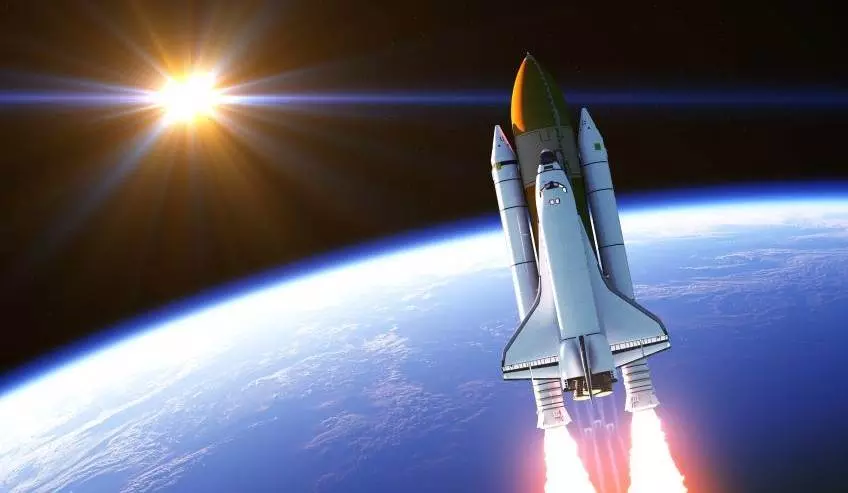Comments
- No comments found

For as long as human beings have been on this planet, the concept of exploring outer space has been an intriguing one.
In more recent years, the space industry has boomed as impressive technological advancements have increased the scope of possibilities.
As companies continue to innovate and develop renewable rockets, satellites and explore the emerging intrigue of space tourism, Bank of America predicts that the space economy will more than triple over the next decade.
All of this suggests one thing: huge potential for emerging space companies to thrive in a growing industry. One company that’s exploring the industry with great ambition is AST SpaceMobile, but are they likely to be successful on their business journey?

As a startup company that’s currently speculating about breakthrough space technology, AST SpaceMobile seems to have unlimited potential in a growing industry. It is currently exploring the idea of building a collection of low-orbit satellites capable of providing a space-based cellular broadband network that’s directly accessible from standard mobile phones.
The company’s ambitious goal is to leverage space technology to provide superior customer service, combining two expanding market concepts to deliver exceptional results. To better assess the company’s prospects, let’s start from the beginning.
In 2017, a company called AST & Science was founded by Abel Avellan. A year later, it acquired majority control of NanoAvionics, a modular platform manufacturer for nanosatellites. It subsequently began work on the Micron project, a venture greatly assisted by a $22m injection of funding from the European Commission. Abel became Chairman of NanoAvionics in 2018 and a year later shifted to the SpaceMobile project, refocusing efforts into this communication constellation.
NanoAvionics has continued to maintain a consistent direction in the midst of AST merging with SPAC New Providence. This merger was orchestrated with the ambition to start launching a fleet of satellites in late 2022. AST SpaceMobile Inc has thus started to grab the attention of prospective investors, who are intrigued by the ambitious nature of the company’s developments.
Since the company was founded, R&D efforts have shifted dramatically as the focus has shifted from nanosats to gigantic satellites. The contrasting nature of these two initiatives makes it very difficult to develop in both areas, where the development of gigantic satellites consumes significant company resources. AST’s only current satellite is a BlueWalker 1 built by NanoAvionics, an early development that has predisposed the company’s progressive focus.
NanoAvionics has very little expertise in building large satellites, which suggests it will have very little impact on AST SpaceMobile’s expansive plans. NanoAvionics also has very few critically important partnerships to facilitate the AST SpaceMobile project, so its relevance to future projects is under scrutiny. Meanwhile, the question of whether acquiring a share in NanoAvionics was necessary remains open to AST investors.
One of the biggest problems for the company now is that it has gone public as a SPAC instead of an IPO. This has created cause for concern because this method of going public has become a distraction. SPACs usually attempt to attract investments on hype rather than the strength of the technology or product in question. And with AST’s product, there is much to be aware of.
AST’s experimental desires are certainly risky, especially when you consider its lack of experience with large satellites. Thus, the question remains, can AST SpaceMobile really work at scale if and when its constellation is deployed?
It has already raised concerns from NASA and Tech Freedom after requesting the FCC to control the SpaceMobile satellite constellation at an altitude of 720km. This has created cause for concern because an existing satellite group has already been working for NASA and the USGS.
The collision risk is quite alarming as well. Especially when you consider the large volumes of debris entering the orbit and the size of the satellites in question. This issue is further compounded by AST’s lack of experience with heavy and complex vehicles and NASA’s increasing safety focuses.
Meanwhile, AST has announced Senate support, cooperation with NASA on providing in-orbit safety measures, and SpaceMobile validation.
As outlined in greater detail by TipRanks, AST Space mobile has a full set of financial and corporate risks above the sector average. The company plans to launch its first commercial satellites between 2022 and 2023, expecting to bridge 49 countries with 20 satellites.
The question is, how does AST expect to implement such a large constellation in such little time? The company’s BW3 is set to be launched under an experimental permit, however, licensing information released online suggests the whole constellation is pending.
The company’s launching test satellite has already been delayed, after originally being arranged to launch in conjunction with a commercial Soyuz vehicle. AST decided to switch to a SpaceX Falcon 9 ride-share rather than launch its BlueWalker-3 satellite as agreed before.
Nonetheless, AST expects to go ahead with plans to build 214 low-earth orbiting satellites across 16 orbital planes at 700km above sea level. Papua New Guinea recently issued a license to AST so it can operate as a satellite system. Meanwhile, a non-profit organization TechFreedom has raised concerns, speaking on how Papua New Guinea has an entire governmental budget of less than $6bn. With this being said, how could the country be responsible for AST’s licensing when its planned orbit is expected to exceed $10 billion?
Besides the risk and uncertainty explained already, the state of AST’s financial affairs is questionable too. For the first six months in 2021, the net loss experienced by AST shareholders rose to $31.5m, an alarmingly different figure from the $9.9m loss over the same period in the previous year.
Operating expenses also doubled to $25.1m in the second quarter of 2021, with capital expenditures of $54.3m. Losses are expected to increase until AST SpaceMobile starts generating revenue. Until then, rising operating expenses, capital expenditures, increasing losses, and cash burn are forecasted.
In fact, there’s reason to believe that ASTS has less than a year of cash runaway if free cash flow continues to reduce at 72.2% per year.
However, AST SpaceMobile was able to raise $462m when it went public, so will be largely dependent on the capital market to fund its expansive growth. The company will incur expenses from $1.7bn - $1.9bn to develop its SpaceMobile service, where the first phase of the space network buildout is expected to cost around $300m alone.
With declining shares that are more volatile than 75% of US stocks over the past 3 months, ASTS shares dropped to $6.96 during the SPAC sell-off, down from $25.37 in February. With ASTS stock being very expensive at the moment if the company’s technology fails its shares could end up being worth nothing.
AST SpaceMobile has claimed its “building the first and only space-based cellular broadband network”, but they are certainly not alone on their quest.
It is certainly a competitive industry, with indirect competition arising from the likes of Starlink, Iridium, and OneWeb. Lynk seems to be the biggest direct competitor but differentiates by operating smaller satellites at lower altitudes. Its orbits are self-cleaning and deorbit quickly at the end of life, a convenience that separates the business from AST SpaceMobile.
Virginia company Lynk alone has shown promise when successfully leveraging unmodified mobile phones to connect to satellite internet services. With more than 36 testing partners and 1.5bn mobile phone subscribers worldwide, Lynk is planning a constellation of 5,000 satellites that will operate in lower altitudes which are self-cleaning. An immense benefit for Earth’s orbit where millions of pieces of space junk are flying in weightlessness.

AST’s adventurous, ambitious plans have been met with great uncertainty. Though with great risk comes great reward, investing in the company could represent setting yourself up for failure. It’s certainly an unpredictable market, a boom-and-bust industry where some excel and others fall by the wayside. But it totally depends on the person which side to choose.
Leave your comments
Post comment as a guest